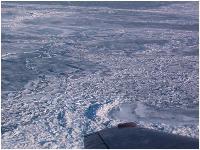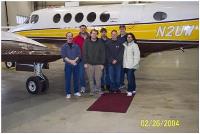
The type and amount of ice on Lake Erie was observed during a recent field study of the atmosphere over the partially ice-covered Lake Erie. This photo, taken from the University of Wyoming King Air, by one of the participants shows that the character of the ice can change dramatically over short distances.
The atmospheric boundary layer changes dramatically as the air moves across various types of surfaces. In order to predict and understand how these affect weather systems, numerous observations have been taken and numerical modeling simulations have been conducted. A particularly difficult problem is to characterize how the atmosphere responds to surfaces that vary a great deal over short distances.
One example of this is air flowing over a partially-frozen lake. Pack ice on these lakes can be compressed together, broken apart, freeze or thaw at different rates over lake surfaces. Gerbush, Kristovich, and Laird (2008, Journal of Applied Meteorology and Climatology) examined how the atmosphere responded to variable ice cover over Lake Erie using observations taken by the University of Wyoming King Air aircraft. They found notable differences in air temperature and humidity between ice-covered regions and those regions with more open water. Surprisingly, the rate of upward sensible heat exchange between the lake and air was only notably affected by the ice when it covered more than about 70% of the lake surface.

Dr. David Kristovich (ISWS) and Prof. Neil Laird (Hobart and William Smith Colleges) were joined by graduate students and staff of the ISWS and University of Illinois during a field study of the atmosphere over the partially ice-covered Lake Erie.